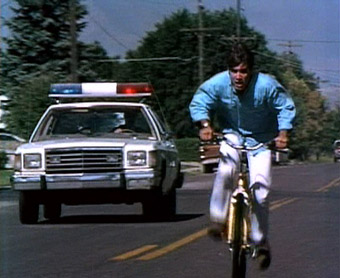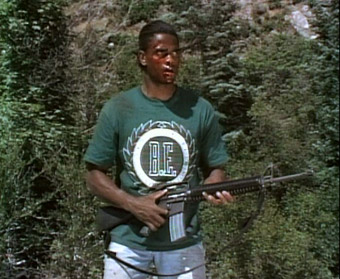|
Pure Race is a disc that arrives some thirteen years after the original release, seventeen years after shooting originally started, and a good deal of format changes on from the S-VHS tapes on which the film was shot. It's tempting to think that Pure Race has been waiting for a time when the pleasures that it offers can be consumed in full. The film should not be seen in the cinema, on television, or on a digital download – it was born for DVD, and it represents the home viewing experience perfectly. Here is a disc that looks low budget, feels high budget, and provides us with an insight into the love and enthusiasm that went into its making.
The film was shot by Rocco DeVilliers for $15,000 over a period of around four years, using the director's friends as cast and crew, improvised locations and on-the-fly techniques to get the shots. Such a blurb normally suggests bedroom horror or small-town slackerdom, however what is delivered here is an ambitious action piece complete with moral message and some social commentary. Fred Hunting plays Tony, a university student who gets a lift home to Colorado from Carl (Greg Hanes), an African-American student. The pair are traveling through Idaho when their car breaks down, and turning to a small farmhouse for help they instead encounter a neo-nazi militia led by the charismatic James Grey (Marvin Payne). Before long they become witness to a lynching and are captured with the promise of trial, torture and execution.

The plot of is pretty standard for an action film, but there are some balancing and character issues that hamper proceedings slightly. The story appears to be building up to a trial scene (with chief Nazi Grey even showing up wearing a tuxedo at one point), before sharply changing gear and launching into a sequence where Carl and Tony are released into the wilderness and then hunted in the style of The Most Dangerous Game. Likewise the buddy elements of the script aren't quite thoroughly explored. Tony and Carl's growing friendship isn't entirely believable, given that for much of the film they are apart; this despite an early diner scene in which some character backstory is forced in and never returned to. Indeed, when Tony tells Carl at the end of the film that he's learned a lot from him, you're left wondering what exactly. Although much of the film focuses on Carl's ethnicity, an opportunity is missed to explore the same issues with Tony, described by Grey as 'a communist jew'; the idea of a white character and a black character being persecuted for the same reason is interesting, and its a shame that more isn't made of it.
Nitpicking aside, the screenplay incorporates all of the old genre favourites. Not only do we get a hunting humans sequence, but also a First Blood–style police car vs bike chase; a scene in which the villain executes one of his own men for failure; a moment where the hero is being smuggled through an enemy checkpoint; a cliff top fist-fight and a jailbreak. Amongst all of this De Villiers and fellow writer Fred Hunting manage to incorporate some subtler elements of setting. A world of racial prejudice and discrimination is created through small moments; Tony's room-mate collecting his change from the bathroom before allowing Carl to use it, Carl being racially abused by a patron at a diner, Neo-Nazi Steve attempting to explain how ordinary people turn to extremism. There is even something akin to social commentary when it is revealed how institutionalized Nazism has become in the town, extending into law enforcement and politics. The film ends on a downbeat note, when after all of the action melodrama and pantomime villains Carl is subjected to a very ordinary and everyday indignity that makes the film's message all the more caustic. It is a brave ending to a film that ambitiously manages to mix spectacle and message in a way that would put many big-budget contemporary productions to shame.
The cast put in very enthusiastic and spirited performances. Gregory Haynes makes for an effective lead, and handles the action portions of the film very handsomely. Fred Hunting makes the best of a bad character – Tony is infuriatingly cowardly and indecisive, though there is some small portion of character growth with a romantic sub-plot involving Kim, the daughter of the senior Nazi. By far the best performance is Marvin Payne as James Grey, the leader of the militia. Payne's smooth delivery and hard stare, coupled with some of the film's best lines ('just breathing makes you guilty' is particularly memorable) make for a superb antagonist. In the commentary the director reveals that many small character touches were at the suggestion of Payne, and a scene in which Grey suggests to Kim that his extremism is out of concern for her wellbeing is chilling, adding an extra layer to what could be a two-dimensional character.

Visually, the film shows its age. The quality of SVHS is unfortunately associated with home video shows and corporate training videos, and the image is murky and inconsistent. However, seen on a television through DVD does serve to hide some of this – after all, SVHS is intended for domestic rather than cinematic viewing. Likewise the budgetary constraints, and the filming over a long period of time mean that there are problems with spatial editing. In many scenes we get no concrete sense of space due to the lack of establishing shots and an over-reliance on close-ups, all of which often make for a confusing experience. Similarly there are some slightly odd lighting arrangements, for example a night scene in Grey's kitchen is lit using blue, orange and white lights that give the sequence a surreal and distracting hue – through again this was probably a money issue. The sound is a little off; the dubbing sits awkwardly with the ambient sound and the music is terrible. Despite these slight flaws, the great pleasure of Pure Race is watching a low budget piece utilize the techniques of expensive Hollywood cinema. The action scenes are a joy to watch despite the image quality, and are tightly shot and edited to maximize the excitement. There are also some dynamic camera movements, in particular some kinetic work used for the car/bike chase scene as the camera weaves in and out of parked cars and speeds alongside the pursuer's vehicle. The climactic hunt sequence is similarly exciting, quick cuts show actors leaping over rocks as bullets ricochet around them and some grungy fist fights are expertly choreographed.. Its terrific stuff, and its difficult not to be swept along with the energy of these scenes.
This is where the pleasure of Pure Race lies. There may be some script problems and the financial constraints on the production bleed onto the screen, but the passion and zeal that went into making the film outshine this. By the time you see Carl driving a pick-up truck through Nazi gunfire, or staring at the American flag through the bars of a prison cell, a decades-old production starts to look like the most inventive film in a long time.
As already stated, Pure Race was shot on Super-VHS, which is a pre-digital analogue video format and has a resolution lower than even the more basic digital camcorders of today. The image is thus some way from what we've come to expect as sharp in the digital age, and while the balance of the contrast is sometimes excellent, the whites are sometimes bleached out and darker areas lacking in detail. For some this will be a problem, but for the reasons given above it shouldn't be, and in its favour te colours are bolder that the source format might lead you to expect. The framing is a somewhat unusual 1.22:1, slightly windoxed withing a 4:3 frame.

The sound is an unfussy but serviceable Dolby 2.0 mono, which is clear enough b ut lacks range and punch, but this is a low budget, analogue video movie, and in that respect the sound serves the picture well enough.
The disc contains some deleted scenes (3:54) – two contain some slight modifications to existing sequences, but the most interesting is a scene in which a father brings his son to see James Grey, and we see the indoctrination of the boy first hand.
The feature commentary from director Rocco DeVilliers and lead actor Gregory Haynes is lively and anecdotal, and will be of great use to directors working on a low budget. Were given an insight into the energy and dedication it took to make the film, and the two seem to have fun in reminiscing over the experience.
The disc also includes a theatrical trailer (2:24) and some dodgy Powerpoint-style menus.
Watching Pure Race on DVD is home video at its best: something made cheaply but with a real love for the medium. It is a disc tailor made for audiences in college dorm rooms and at local film festivals. The production has found its best form on DVD – the commentary adds to the sense of a shared experience, both in production and in viewing. Highly recommended.
|